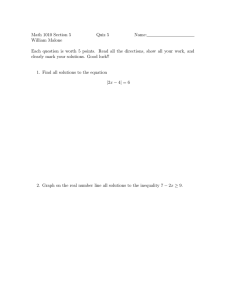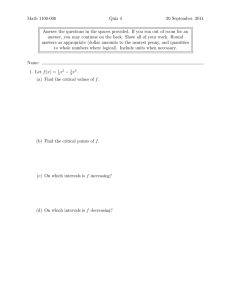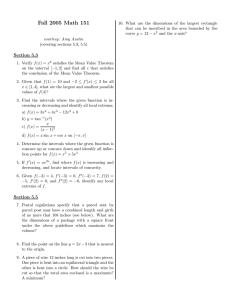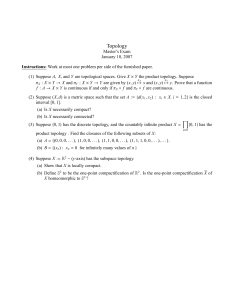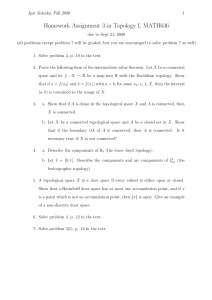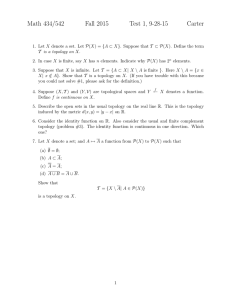Solutions to Problem Set 1 Robert Young September 19, 2015
advertisement
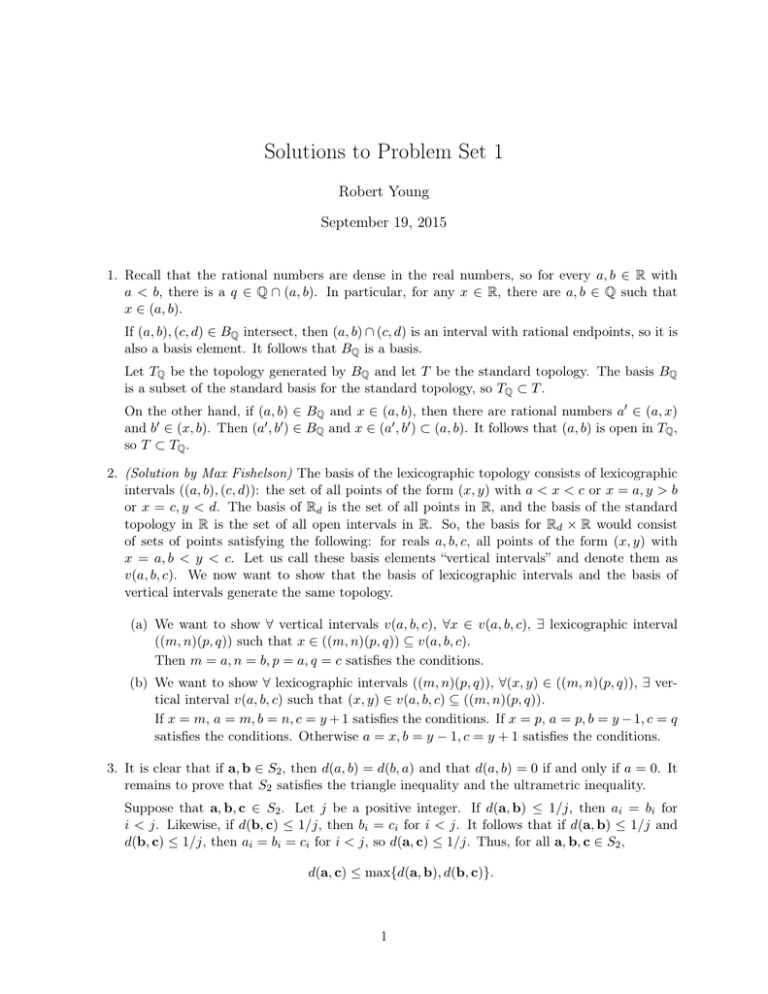
Solutions to Problem Set 1
Robert Young
September 19, 2015
1. Recall that the rational numbers are dense in the real numbers, so for every a, b ∈ R with
a < b, there is a q ∈ Q ∩ (a, b). In particular, for any x ∈ R, there are a, b ∈ Q such that
x ∈ (a, b).
If (a, b), (c, d) ∈ BQ intersect, then (a, b) ∩ (c, d) is an interval with rational endpoints, so it is
also a basis element. It follows that BQ is a basis.
Let TQ be the topology generated by BQ and let T be the standard topology. The basis BQ
is a subset of the standard basis for the standard topology, so TQ ⊂ T .
On the other hand, if (a, b) ∈ BQ and x ∈ (a, b), then there are rational numbers a0 ∈ (a, x)
and b0 ∈ (x, b). Then (a0 , b0 ) ∈ BQ and x ∈ (a0 , b0 ) ⊂ (a, b). It follows that (a, b) is open in TQ ,
so T ⊂ TQ .
2. (Solution by Max Fishelson) The basis of the lexicographic topology consists of lexicographic
intervals ((a, b), (c, d)): the set of all points of the form (x, y) with a < x < c or x = a, y > b
or x = c, y < d. The basis of Rd is the set of all points in R, and the basis of the standard
topology in R is the set of all open intervals in R. So, the basis for Rd × R would consist
of sets of points satisfying the following: for reals a, b, c, all points of the form (x, y) with
x = a, b < y < c. Let us call these basis elements “vertical intervals” and denote them as
v(a, b, c). We now want to show that the basis of lexicographic intervals and the basis of
vertical intervals generate the same topology.
(a) We want to show ∀ vertical intervals v(a, b, c), ∀x ∈ v(a, b, c), ∃ lexicographic interval
((m, n)(p, q)) such that x ∈ ((m, n)(p, q)) ⊆ v(a, b, c).
Then m = a, n = b, p = a, q = c satisfies the conditions.
(b) We want to show ∀ lexicographic intervals ((m, n)(p, q)), ∀(x, y) ∈ ((m, n)(p, q)), ∃ vertical interval v(a, b, c) such that (x, y) ∈ v(a, b, c) ⊆ ((m, n)(p, q)).
If x = m, a = m, b = n, c = y + 1 satisfies the conditions. If x = p, a = p, b = y − 1, c = q
satisfies the conditions. Otherwise a = x, b = y − 1, c = y + 1 satisfies the conditions.
3. It is clear that if a, b ∈ S2 , then d(a, b) = d(b, a) and that d(a, b) = 0 if and only if a = 0. It
remains to prove that S2 satisfies the triangle inequality and the ultrametric inequality.
Suppose that a, b, c ∈ S2 . Let j be a positive integer. If d(a, b) ≤ 1/j, then ai = bi for
i < j. Likewise, if d(b, c) ≤ 1/j, then bi = ci for i < j. It follows that if d(a, b) ≤ 1/j and
d(b, c) ≤ 1/j, then ai = bi = ci for i < j, so d(a, c) ≤ 1/j. Thus, for all a, b, c ∈ S2 ,
d(a, c) ≤ max{d(a, b), d(b, c)}.
1
Finally,
max{d(a, b), d(b, c)} ≤ d(a, b) + d(b, c),
so the ultrametric inequality implies the triangle inequality.
4. (a) Open balls in an ultrametric space have many centers. That is, for all x ∈ X and r > 0,
if y ∈ Br (x), then Br (x) = Br (y).
Suppose that x ∈ X, r > 0 are such that y ∈ Br (x). Then d(x, y) < r. If z ∈ Br (x),
then d(x, z) < r, so
d(y, z) < max{d(x, z), d(x, y)} < r,
and z ∈ Br (y). Thus Br (x) ⊂ Br (y). Conversely, x ∈ Br (y), so Br (y) ⊂ Br (x), and the
two balls are equal.
(b) Let B = Br (x) and B 0 = Br0 (y) and suppose that B ∩ B 0 6= ∅. Let z ∈ B ∩ B 0 . By the
previous question, B = Br (z) and B 0 = Br0 (z), so we have B ⊂ B 0 or B 0 ⊂ B depending
on whether r ≤ r0 or r0 ≤ r.
0
(c) Suppose that {yi }∞
i=1 is a sequence in Br (x) such that yi converges to y. Let B = Br (y).
Then yi ∈ B 0 for all sufficiently large i, so B 0 and Br (x) intersect. By our previous work,
B 0 = Br (x), so in particular, y ∈ Br (x).
2
